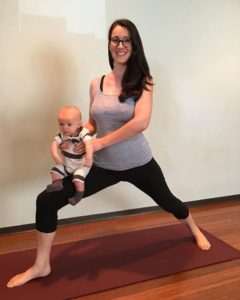I led a Prenatal Yoga workshop at Purple Yoga and was reminded of my passion for women’s health, especially during vulnerable times like pregnancy and birth. I just love all things pregnancy and babies and of course, yoga! So I thought I’d share the guide I made for my students. It serves as an accompaniment to the in person instruction and I’m sure makes more sense in context, but I still think it would be a good resource for yogi mamas who already have some familiarity with yoga. I hope it’s helpful! Click Here For PDF 
Prenatal Yoga: General Guidelines, Tips, and Resources
Your body is undergoing rapid and dramatic transformation! It is more important than ever to LISTEN TO YOUR BODY, number one rule of yoga whether you’re pregnant or not. Allow and embrace the limits pregnancy puts on your body. Trust your instincts. Get into what feels good and back away from what doesn’t feel good.
In general, if you are having a normal low risk pregnancy, whatever activities you performed regularly before you got pregnant you are safe to do during pregnancy. Of course, proceed mindfully, within reason, listen to your body and listen to your doctor.
Here are the main concerns and modifications when proceeding with your yoga practice:
- Stay grounded, watch your footing. Feet apart hip width or wider
- Give belly space, no movements which compress on the belly
- Maintain stability in the joints, careful not to over-extend. The hormone relaxin is at work not only in your pelvis but all over your body and the extra mobility can create instability.
- Down Dog – Great during pregnancy! Allows the pelvic floor to rest. Some precautions: don’t hold it as long as you would when not pregnant (3 breaths max). There will be days when down dog just doesn’t feel good, take table top or child’s pose instead. Avoid down dog: if you have hypertension or are at risk for pre eclampsia; If you have excessive amniotic fluid in the 2nd or 3rd trimester; In the 3rd trimester, if you had fetal positioning complications but now positioning is ok
- Inversions – Only if part of your practice before pregnancy. Listen to your body! Do not put too much load on the cervical spine (due to increased mobility in the joints) i.e. headstand, plow
- Backbends – Only if part of your practice before. No intense backbends, could encourage more separation of the rectus abdominus muscles
- Laying flat on your back – After 4 or 5 months, only one or two minutes at a time. Instead lay on your sides. Left side is the best side* to rest 3 or more minutes, place a pillow or blanket between your legs and under your neck and head. You could also use a bolster or blocks and blankets to create a ramp that props up your back to recline on.
- Twists – Gentle twists help maintain spinal mobility and relieve tension in the spine. They should feel good and not compress the belly. Usually twist in the opposite direction in a regular group class. Belly moves away from a leg that’s stepped forward, not into it.
- Sun Salutation A/Vinyasas – Listen to your body! Full out during the 1st and even 2nd trimester is fine if you’re feeling really strong. Best to start to modify sometime in the 2nd trimester, definitely in the 3rd to cat/cow or knees/chest/chin
3rd Trimester Considerations:
- Move slower, take your time
- Modify, i.e. lunges keep back knee on the floor
- If 34+ weeks and baby is still breech, no cobbler/bound angle pose (if baby is head down then do this pose a lot!)
*Left side is best to lay on because you get better circulation/blood flow
Best poses for pregnancy:
Table top, cat/cow – helps with positioning the baby, keeping baby and you more comfortable. Gravity works to bring weight away from your back, makes a little hammock for baby, creates space.
All hip openers:
- Garland pose/low squat – opens the pelvis the most
- Goddess pose & moving squats – strengthen thigh muscles
- Wide angle forward fold & folding with one leg bent in – stretch hamstrings and back, good for sciatic
- Cobbler/bound angle (soles of feet together) – opens and stretches hips
- Happy baby – opens hips
Poses that activate and stretch or release the hip flexors, especially the psoas:
- All lunges
- Warrior 1
- Half pigeon
- Bridge
- Supported bridge – has added benefit of decompressing the low back
Windshield wipers (reclining, knees bent, feet wide, legs sweeping left and right) are also good for releasing tension in the low back and hips
Pelvic tilts/side to side/hip circles (standing, feet parallel, wide stance, soft bend in the knees) – good for low back, opens hips, helps position baby conducive for labor
Poses and exercises that release tension from the neck and shoulders
Best poses for labor, especially with partner support:
First and foremost….. BREATHE! Access your yogic breathing pattern. Deep, rhythmic, nostril breaths.
Wide stance fold, shoulder and back stretch – feet wide apart, reach and fold forward, flat back. Wrist grip with partner and lean hips back. Without partner arms can rest on the arm or back of the couch. Especially good for early labor.
Standing hip circles – between contractions
Supported child’s pose – good resting pose, especially early in labor. Use bolster or blocks. Resting the forehead on the floor, hands or block can be nice as there is that “third eye” pressure point that promotes relaxation.
Supported, reclined, bound angle – the key is lots of support! Bolster, blocks, blankets, pillows. Good resting pose. Hips open to allow baby to descend.
Table top – great for back labor, active labor. Especially good with a partner who can apply pressure with fists on either side of the spine at the low back/sacrum. Even more comfort and support when partner also squeezes your hips with their legs while applying pressure to low back.
Supported squat – low squat/garland pose with arms reaching forward to wrist grip partner. Lean back, let partner carry most of your weight. Especially good in active labor, and a good pushing pose.
Favorite Books/Resources:
When I was pregnant the first time I read ALL THE BOOKS! 🙂 These two were my favorite by far…
Ina Mae Gaskin’s Guide to Childbirth – First half is all natural birth stories. Second half is renown midwife guru Ina Mae’s wisdom on pregnancy, labor, birth process, mind/body connection, all that good stuff! Also, it’s not that long and it’s easy to read. Great for instilling confidence, getting rid of fear, and getting in the right mindset.
Penny Simkin’s The Birth Partner – Penny is the guru doula of all doulas. Lots of practical information here. Not really necessary to read cover to cover, can cherry pick through the information. This is good for mamas to read but especially for your partner to read!
Spinningbabies.com – great resource online for healthy activity while pregnant and how to encourage good positioning for baby. Good positioning can be the difference between an “easy” shorter labor and a “hard” longer labor.







Recent Comments